![]()
![]()
![]()
Use LEFT and RIGHT arrow keys to navigate between flashcards;
Use UP and DOWN arrow keys to flip the card;
H to show hint;
A reads text to speech;
51 Cards in this Set
- Front
- Back
- 3rd side (hint)
|
What does the human body look like? In terms of digestion. |

Oesophagus (Carried food from mouth to stomach) -> Stomach (Store and digest food, especially proteins as they have enzymes to digest them) -> Ileum (small intestine) (Digests even more and absorbs products of digestion in bloodstream) -> Colon (large intestine) (absorbs water) -> rectum (goes through egestion (faeces is removed periodically). |
|
|
|
In which two main stages does digestion occur? |
• Physical breakdown - Food broken down by teeth. Food is churned by muscles in the stomach wall. • Chemical digestion - Hydrolysis large, insoluble molecules into smaller soluble ones. |
|
|
|
How are carbohydrases, lipases and proteases part of digestion? |
• Carbohydrase hydrolyse carbohydrates, ultimately to monosaccharides. • Lipase hydrolyse lipids (fats and oils) into glycerol and fatty acids. • Proteases hydrolyse proteins, ultimately to amino acids. |
|
|
|
How is amylase involved in the the digestion of carbohydrates? |
Amylase is a digestive enzyme that catalyses the breakdown of starch. It works by catalysing hydrolysis reactions that break glycosidic bonds. Amylase is produced in the salivary glands, which release amylase in the mouth, and also by the pancreas, which release amylase in the small intestine. |
|
|
|
How are Lipase and bile salts involved the digestion of lipids? |
• Lipase enzymes catalyse the break down of lipids into monoglycerides and fatty acids. This involves the hydrolysis of ester bonds in lipids. • Lipases are mainly made in the pancreas, they are then secreted into the small intestine where they act. • Bile salts are produced by the liver and emulsify lipids, this means they cause the lipids to form small droplets. • The formation of small droplets increases as the bile salts emulsifies a big lipid droplet. The small droplets have a larger surface area. • Once the lipid has been broken down with lipase, the monoglycerides and fatty acids stick with the bile salts to form tiny structures called micelles. Micelles help the products of lipids digestion. |
|
|
|
How are Membrane-bound dissacharides involved in the digestion of carbohydrates? |
They are enzymes that are attached to the cell membranes of the epithelial cells lining the ileum (final part of small intestine). They help to break down dissacharides into monosaccharides (hydrolysis of glycosidic bonds) |
|
|
|
How are endopeptidases, exopeptidases and dipeptidases involved in the digestion of proteins? |
• Endopeptidases act to hydrolyse peptide bonds within a protein. • Exopeptidases act to hydrolyse peptide bonds at the ends of protein molecules. The remove single amino acids from proteins. • Dipeptidases are exopeptidases that work specifically on dipeptidases. |
|
|
|
Where are the proteins digestive processes located in the body? |
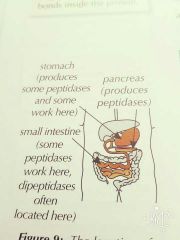
|
|
|
|
How are each of the following absorbed across the ileum epithelium into the bloodstream: • Monosaccharides • Monoglycerides and fatty acids • Amino acids |
• Monosaccharides - Glucose is absorbed with sodium ions via a co-transporter protein. Galactose is absorbed in the same way using the same co-transporter protein. Fructose is absorbed via facilitated diffusion through a different transporter protein. • Monoglycerides and fatty acids - Micelles help to move monoglycerides and fatty acids towards the epithelium. Whole micelles are not taken up across he epithelium but monoglycerides and fatty acids are lipid-soluble so they can diffuse directly across. • Amino acids - Amino acids are absorbed in a similar way to glucose and galactose. Sodium ions are actively transported out of the epithelial cells into the ileum itself. They then diffuse back into the cells through sodium-dependent transporter proteins into epithelial cell membranes, carrying amino acids with them. |
|
|
|
What haemoglobin a group of? |
They are a group of chemically similar molecules found in many organisms. |
|
|
|
What sort of a protein is haemoglobin? |
A protein with a quaternary structure. |
|
|
|
In the lungs what happens to haemoglobin? |
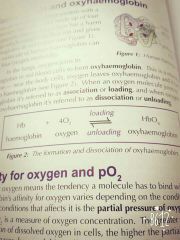
Oxygen joins onto them to form oxyhaemoglobin |
|
|
|
What does it mean by affinity for oxygen and PO2? |
• Affinity for oxygen means the tendency a molecule has to bind with oxygen. • PO2 is a measure of oxygen concentration. The greater the concentration of dissolved oxygen in cells, the higher the partial pressure. • Oxygen loads onto haemoglobin to for oxyhaemoglobin where there's a high PO2. |
|
|
|
What is difference of oxygen loading/unloading in the body? |

|
|
|
|
What does it look like on a graph when PO2 is high or low? |
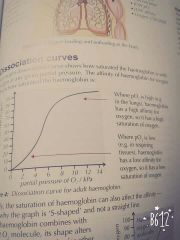
|
|
|
|
Why are dissociation curves S-shaped? |
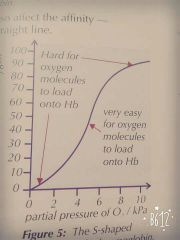
|
|
|
|
How does carbon dioxide concentration affect oxygen unloading? |

• When cells respire, they release CO2, which increases the rate of oxygen unloading. • The dissociation curve 'shifts' right. • The saturation of blood is lower for a given PO2, meaning that more oxygen is being released. |
|
|
|
Name the main blood vessels and where they carry blood from and to. |
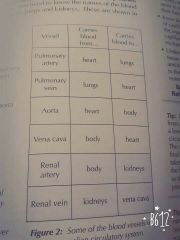
|
|
|
|
Name main blood vessels on the heart. |
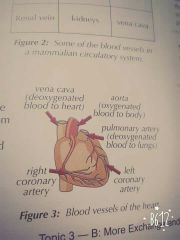
|
|
|
|
Why are arteries important? STRUCTURE? |
• They carry blood away from the heart and to the body. • Their walls are thick and muscular and have elastic tissue to stretch and recoil as the heart beats, which helps maintain the pressure. • The inner lining (endothelium) is folded, allowing the artery to stretch this also maintain high pressure. |
|
|
|
Why are arterioles important? |
• They form a network throughout the body. • Blood is directed to different areas of demand in the body by muscles inside the arterioles, which contract to restrict the blood flow or relax to allow full blood flow. |
|
|
|
Why are veins important? Structure? |
• They take back blood under low pressure. • They have wider lumen than equivalent arteries, with very little elastic or muscle tissue. • Veins have valves to stop blood flowing backwards. • Blood flow through veins is helped by contraction of the body muscles surrounding them. |
|
|
|
Why are capillaries important? STRUCTURE? |
• Smallest blood vessel. • Substances (like oxygen or glucose) are exchanged between cells and capillaries, so they're adapted efficient diffusion. • They are found near cells in exchange tissues, so there's a short diffusion pathway. • Also, their walls are only a cell thick, which also shortens the diffusion pathway. • Networks of capillaries are called capillary beds. |
|
|
|
Tissue fluid? |

|
|
|
|
How does substances move out othe capillaries into the the tissue fluid? |
By pressure Filtration. |
|
|
|
What is the structure of the heart? How is it adapted to doing it'should job properly? |
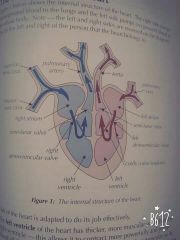
• Left ventricle - Has thicker muscular was than the right ventricle as it has to contract powerfully enough to pump blood around the whole body. • Ventricles - Have thick walls because it needs to push blood out of the heart. • Atrioventricular valves - Link the atria to the ventricles and stops blood flowing backwards. • Semi-lunar valves - Link the ventricles to the pulmonary artery and aorta and stops blood flowing backwards. • Cords - Attach the atrioventricular valves to the ventricles to stop them being forced up into the atria when the ventricles contract. |
|
|
|
How would you do a heart dissection? |

|
|
|
|
What does the heart do when the ventricles relax and the atria contact? |
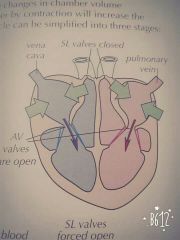
|
|
|
|
What does the heart do when the ventricles contract and the atria relax? |

|
|
|
|
What does the heart do when the ventricles and the atria are both relaxed? |
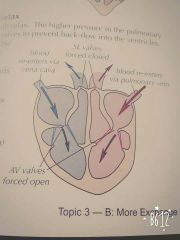
|
|
|
|
How do you work out cardiac output? |
Cardiac output = Stroke volume × Heart rate |
|
|
|
What is heart rate? |
The number of beats per minute. |
|
|
|
What is the stroke volume? |
The volume of blood pumped during each heartbeat, measured in cm^3. |
|
|
|
What is arethroma formation? |

Arethroma is a fibrous plaque. |
|
|
|
What is an aneurysm? |
• Balloon-like swelling of the artery. • Starts with formation of atheroma. • When blood moves are high pressure through smaller amount of space the inner layers of the artery push through the outer layers. • The aneurysm may burst, causing a haemorrhage (bleeding). |
|
|
|
What is thrombosis? |
• It is the formation of a blood clot. • Starts with a arethroma formation. • The arethroma plaque can rupture the endothelium of an artery. Which damages the artery wall. • Platelets and fibrin accumulate at the site of damage and from a blood clot. |
|
|
|
What is myocardial infarction? |
• The heart muscle is supplied with oxygen from coronary arteries, so the heart muscle cells can carry out respiration. • If a coronary artery becomes blocked it would cut of the blood supply. |
|
|
|
What can high blood pressure lead to? |
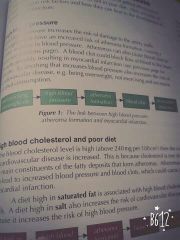
|
|
|
|
What can high blood cholestrol and a poor diet lead to? |
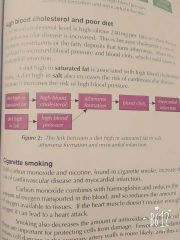
|
|
|
|
What can cigarette smoking lead to? |
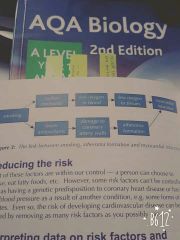
|
|
|
|
What does the Xylem and Phloem do? |
• Xylem - Transports water and mineral ions in solution. These substances move up the plant from the root to the leaves. • Phloem - Transports organic substances like sugars (also in solution) both up and down the plant. |
|
|
|
What is the structure of the xylem? |
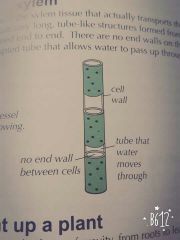
They are very long, tube-like stuctures formed from dead cells joined end to end. |
|
|
|
How does water move up a plant? |
• Water evaporates from leaves. This process is called transpiration (when the stomata opens, water moves out of the leaf down the water potential gradient). • The creates tension (suction), which pulls more water into the leaf. • Water molecules are cohesive so when some are pulled into the leaf others follow. This means the whole column of water in the xylem, from the leaves down to the roots, moves upwards. • Water then enters the stem through the roots. |
|
|
|
What factors affecting the transpiration rate? |
• Light intensity - The lighter it is the, the faster the transpiration rate is. This is because when the stomata opens when it gets light to let CO2 in for photosynthesis. • Temperature - The higher the temperature is the faster the transpiration rate is. Warmer water molecules have more energy so they evaporate quicker. • Humidity - The lower the humidity, the faster the transpiration rate because it has a better effect for the water potential gradient. • Wind - The windier it is, the faster the transpiration rate is because it blows the water molecules of. |
|
|
|
Looking at the xylem and Phloem stem experiment. |
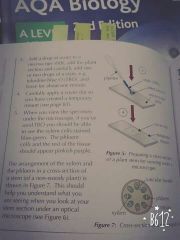
|
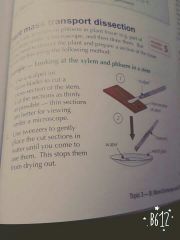
|
|
|
How would you use a potometer? |

|
|
|
|
What is the structure and the function of the phloem? |

• They have sieve tube elements that are living cells, that form the tube for transporting solutes. They have no nucleus and few organelles. • There's a companion cell for each tube element. They carry out living functions for sieve cells, for example, providing the energy needed for the active transport of solutes. |
|
|
|
What is translocation? |
• Translocation is the movement of solutes (e.g. amino acids and sugars like sucrose) to where they'really needed in the plant. • Solutes are sometimes called assimilates. • It's an energy-requiring process that happens in the phloem. • Translocation moves solutes from 'sources' to 'sinks'. The source is where the assimilates are made and the sink is where the assimilates are used up. • Enzymes maintain a concentration gradient from the source to the sink. |
|
|
|
What is the mass flow hypothesis? |

1) Source - Active transport is used to actively load solutes from companion cells into the sieve tubes of the phloem at the source. This lowers the water potential inside the sieve tubes, so water enters the tubes by osmosis from the xylem and companion cells. This creates a high pressure inside the sieve tubes at the source end of the phloem. 2) At the sink end, solutes are removed from the phloem to be used up. This increases the water potential inside the sieve tubes, so water also leaves the tubes by osmosis. Which lowers the pressure in the sieve tubes. 3) This results in a pressure gradient from the source end to the sink end. This gradient pushes solutes along sieve tubes towards the sink the solutes will be used or stored. The higher the concentration of sucrose at the the source, the higher the rate of translocation. |
|
|
|
Evidence of mass flow? |
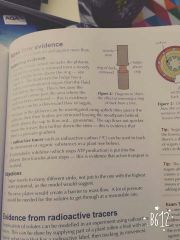
|
|
|
|
Evidence from radioactive tracers |
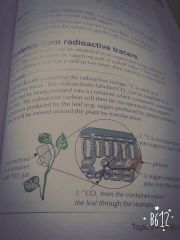
|
|

